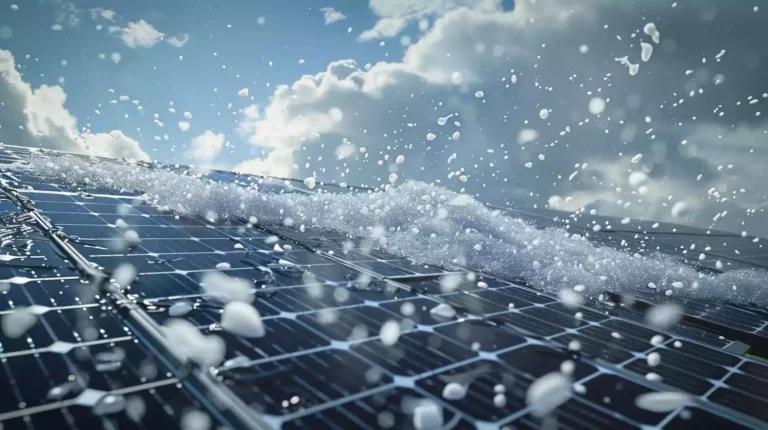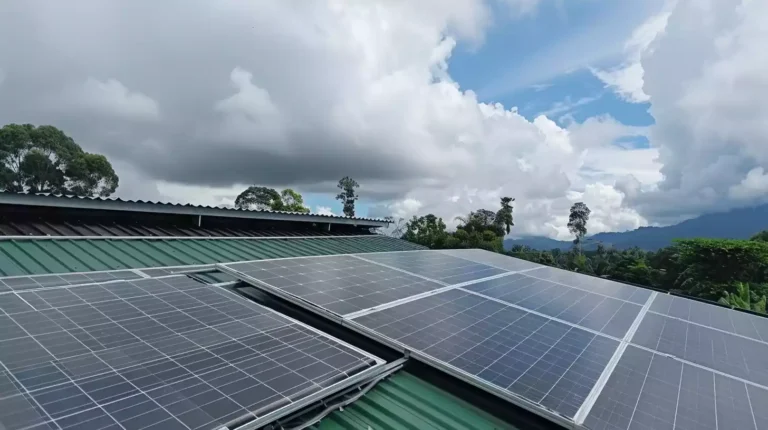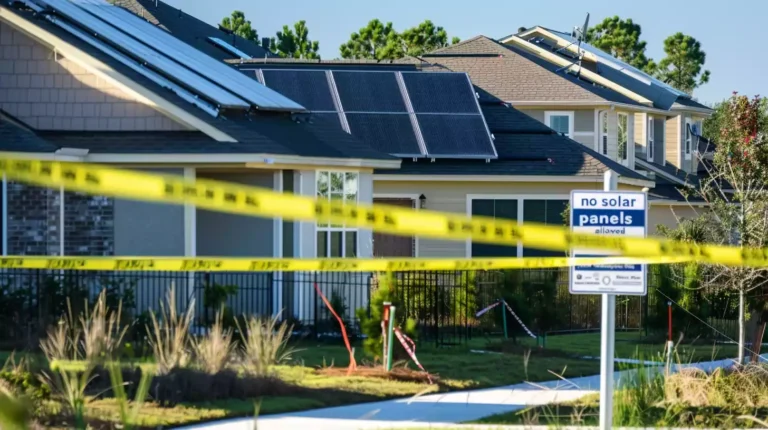Friendly Fliers or Feathery Foes? Can Birds Damage Solar Panels?
Certainly, birds can cause damage to solar panels. Their nesting habits can interfere with the panels’ functionality and lead to potential fire risks. Moreover, bird droppings can corrode panel surfaces over time, reducing their efficiency.
I recommend to regularly inspect and maintain solar panels to prevent long-term damage. Addressing these issues promptly can avoid blockages and hazards, ensuring the panels operate at their best.
Learn more about how to protect your solar panels from bird-related damage below.
Main Points Covered Below
- Bird nesting can interfere with wiring and cause potential fire hazards.
- Bird droppings can corrode panel surfaces over time.
- Droppings can create hotspots in cells, leading to system failures.
- Scratches caused by birds can decrease panel efficiency.
- Birds and their droppings can reduce solar panel efficiency by up to 30%.
Impact of Bird Nesting on Solar Panels
Bird nesting beneath solar panels poses significant risks to their functionality and longevity. When birds decide to make a cozy home under your solar panels, they bring along a host of issues.
Not only does their nesting debris cause accumulation that can interfere with wiring and potentially lead to gutter problems, but it also creates a messy situation with bird droppings. These droppings not only look unsightly but can also corrode the panel surfaces over time if left unchecked.
Regular inspection and maintenance are crucial to prevent birds from nesting under solar panels and causing long-term damage.
Birds like gulls are particularly keen on setting up their homes in these cozy spots, increasing the risk of interference with the panels’ functionality. By addressing nesting under solar panels promptly, you can avoid issues like blockage of airflow, corrosion, and even potential fire hazards.
Risks of Bird Droppings on Panels
Bird droppings on solar panels pose significant risks, including damage to the panels, challenges in cleaning, and reduced efficiency.
The acidic nature of bird droppings can lead to etching, impacting the functionality of the cells.
Timely removal of droppings is essential to prevent long-lasting harm and maintain peak panel performance.
Panel Damage Risks
Contending with the risks posed by bird droppings on solar panels requires vigilant maintenance and prompt removal to safeguard panel efficiency and performance.
Bird droppings contain uric acid that can harm solar panels, leading to hot spotting and decreased cell efficiency. The etching caused by these droppings can leave permanent marks on panels, impacting their overall performance.
Quick removal of bird droppings is essential to prevent damage and maintain peak efficiency levels. However, the constant cleaning needed due to bird droppings can be both costly and time-consuming, adding to the maintenance burdens of solar panel owners.
Neglecting to address bird droppings on solar panels can result in reduced energy production, increased maintenance costs, and potential long-term damage.
Cleaning Challenges
Handling the challenges of maintaining solar panel cleanliness due to bird droppings requires consistent vigilance and proactive removal to uphold panel efficiency. Bird droppings contain uric acid that can lead to hot spotting and reduced efficiency.
To mitigate these risks, it’s important to:
- Prevent Nesting: Regularly inspect and seal any gaps under solar panels to deter birds from building nests, minimizing the need for frequent cleanings.
- Deter Birds: Implement bird deterrents like spikes or netting around the panels to keep birds away and reduce the likelihood of droppings accumulating.
- Regular Cleaning: Establish a routine cleaning schedule to swiftly remove any bird droppings, preventing etching and maintaining the best solar panel performance.
Efficiency Impact
Efficiency on solar panels can be greatly impacted by the presence of bird droppings, leading to decreased performance and potential long-term damage.
Birds nesting near or on solar panels can result in droppings containing uric acid, which can cause hot spotting and etching on the panels. This not only affects the appearance but can also permanently mark the surface.
To protect your solar investment, it’s essential to promptly remove any bird droppings to prevent such damage and maintain best panel efficiency. Failure to do so may lead to cells functioning inefficiently due to hot spotting, in the end impacting the overall energy production.
Constant cleaning due to bird droppings can be both costly and time-consuming, making preventive measures critical for the longevity and effectiveness of your solar panels.
Corrosion and Scratches From Birds
Bird droppings on solar panels pose a significant risk of corrosion and scratches, affecting their performance and longevity. These factors can have a detrimental impact on the efficiency of solar panels over time.
Here are three key points to take into account:
- Corrosion Risk: Bird droppings contain uric acid, which can lead to corrosion on the surface of solar panels. This corrosion can eat away at the protective coating, leaving the panels vulnerable to further damage and reducing their ability to generate electricity efficiently.
- Scratch Concerns: Scratches caused by birds perching on solar panels can also decrease their efficiency and lifespan. These scratches create areas where dirt and debris can accumulate, further hindering the panels’ ability to capture sunlight and convert it into energy.
- Preventive Measures: Regular inspection and cleaning are essential to prevent damage from bird-related corrosion and scratches. By removing bird droppings promptly and ensuring the panels are clear of nesting materials, you can help maintain the performance and longevity of your solar energy system.
Bird-Related Hotspots in Cells
Bird droppings on solar panels can lead to hotspots, causing damage and decreased efficiency in cells. Prevention measures, such as prompt cleanup and regular inspections, are essential to mitigate the risk of hotspots.
Cell Damage Potential
How can bird droppings impact the performance of solar panels, particularly with cell damage potential?
Bird droppings, especially those containing uric acid, pose a significant threat to solar panels due to their ability to create hotspots within the cells. These hotspots can lead to inefficiencies and even potential failures in the solar panel system.
The uric acid in bird droppings is corrosive and can etch the surface of the panels, causing permanent damage over time.
To prevent cell damage from bird-related issues, regular cleaning and maintenance are essential. Here are three vital points to take into account:
- Bird droppings with uric acid can create hotspots in solar cells.
- The presence of bird-related hotspots may lead to system failures.
- Uric acid from bird droppings can cause permanent damage by etching the panel surface.
Prevention Measures
What measures can be taken to prevent the formation of hotspots in solar panel cells due to bird droppings containing uric acid?
To safeguard solar panels from bird-related hotspots, implementing bird deterrent measures is essential. Strategies like installing bird spikes, using visual deterrents, or setting up ultrasonic devices can help keep birds away from nesting near solar panels.
Regularly cleaning the panels to remove any existing droppings is also important to prevent etching and the formation of hotspots.
Importance of Bird-Proofing Measures
Implementing effective bird-proofing measures is essential for safeguarding solar panels from potential damage and hazards. Birds can pose a threat to solar panels by nesting underneath them, causing issues like blockage of airflow, damage to wiring, and even fire hazards.
To address this, several bird-proofing measures can be employed:
- Wire Mesh and Roof Spikes: Installing wire mesh or roof spikes can prevent birds from accessing the space under solar panels, deterring them from nesting and causing damage.
- Bird Deterrent Devices: Utilizing bird deterrent devices like sound emitters or visual repellents can effectively protect solar panels from bird-related issues, reducing the risk of damage and maintenance costs.
- Creating Safe Landing Spots: By creating safe landing spots away from solar panels, birds can be encouraged to perch elsewhere, minimizing the chances of them causing damage to the panels.
Preventing Energy Reduction From Birds
To guarantee maximum energy production from solar panels, addressing the potential reduction caused by bird interference is paramount. Birds, with their droppings, can greatly diminish the efficiency of solar panels, leading to a decrease in energy output by up to 30%.
This reduction not only affects the panel directly underneath but can also impact neighboring panels, eventually resulting in higher utility bills.
The hindrance of sunlight reaching the cells due to bird droppings can impede the overall performance of the solar panel system, making quick removal of the droppings essential to prevent energy loss.
Regular cleaning and maintenance are crucial to ensure that bird-related damage doesn’t compromise the energy production of the panels.
Solutions for Bird-Related Maintenance Costs
Minimizing maintenance costs related to bird interference on solar panels can be achieved through the strategic deployment of bird deterrent devices and regular monitoring for nesting activity. Implementing bird control measures is crucial to guarantee the peak performance of solar panels and reduce unnecessary expenses.
Here are three key strategies to help mitigate bird-related maintenance costs:
- Utilize Bird Deterrent Devices: Installing bird deterrent devices such as reflective tape or ultrasonic repellent systems can effectively deter birds from roosting on solar panels, minimizing the need for frequent cleaning and maintenance.
- Regular Monitoring for Nesting Activity: Conducting routine inspections to identify and remove any bird nests on or near solar panels can prevent long-term damage and decrease maintenance expenses associated with repairs or replacements.
- Install Bird Exclusion Systems: Consider incorporating wire mesh or bird exclusion systems to create physical barriers that deter birds from accessing solar panel areas, reducing the risk of scratches, etching, and other potential damage.
Safeguarding Solar Panels From Bird Damage
Bird damage to solar panels poses significant risks to energy production and maintenance costs, necessitating effective safeguarding measures. To protect solar panels from birds, various solutions can be employed to enhance the panels’ efficiency.
Here is a comparison table highlighting different methods:
| Method | Description | Effectiveness |
|---|---|---|
| Bird Spikes | Physical barriers placed on the panels to deter birds from landing | High |
| Ultrasonic Repellents | Emit high-frequency sound waves to deter birds without disturbing humans | Medium |
| Visual Deterrents | Reflective materials or predatory decoys to scare birds away visually | Low to Medium |
Implementing these safeguarding measures can not only prevent bird-related damage but also improve the overall performance and longevity of solar panels. By choosing the right method based on effectiveness and site-specific factors, solar panel owners can ensure efficient operation and minimize maintenance costs in the long run.
Final Thoughts
While birds can indeed pose a threat to solar panels through nesting, droppings, corrosion, and hotspots, there are effective bird-proofing measures available to safeguard your investment.
By taking proactive steps to prevent damage and reduce maintenance costs, you can guarantee that your solar panels continue to operate efficiently and generate clean energy for years to come.
Remember, a little prevention can go a long way in keeping those pesky birds at bay!






